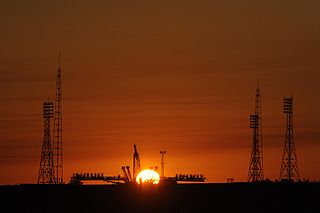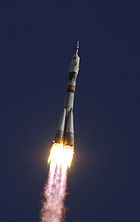| Launch site | Vostochny Cosmodrome | ||||||||
|---|---|---|---|---|---|---|---|---|---|
| Coordinates | 51°52′10″N128°21′26″E / 51.86944°N 128.35722°E Coordinates: 51°52′10″N128°21′26″E / 51.86944°N 128.35722°E | ||||||||
| Operator | Roscosmos | ||||||||
| Launch pad(s) | One | ||||||||
| |||||||||
Site 1A is a launch complex currently under construction at the Vostochny Cosmodrome in Amur Oblast, Russia. It will consist of a single pad for use by Angara rockets. [1] The launch complex is expected to be completed by December 2022 and is being constructed by Kazan Corporation. [2] By October 8, 2018 the entire area of the Angara launch pad was cleared of trees, an activity which began at the end of August. [3]

The Vostochny Cosmodrome is a Russian spaceport under construction on the 51st parallel north in the Amur Oblast, in the Russian Far East. It is intended to reduce Russia's dependency on the Baikonur Cosmodrome in Kazakhstan. The first launch took place on 28 April 2016 at 02:01 UTC. As of December 2018, four launch attempts have been made with three successes.

Amur Oblast is a federal subject of Russia, located on the banks of the Amur and Zeya Rivers in the Russian Far East. The administrative center of the oblast, the city of Blagoveshchensk, is one of the oldest settlements in the Russian Far East, founded in 1856. It is a traditional center of trade and gold mining. The territory is accessed by two railways: the Trans-Siberian Railway and the Baikal–Amur Mainline. As of the 2010 Census, the oblast's population was 830,103.

Russia, or the Russian Federation, is a transcontinental country in Eastern Europe and North Asia. At 17,125,200 square kilometres (6,612,100 sq mi), Russia is by a considerable margin the largest country in the world by area, covering more than one-eighth of the Earth's inhabited land area, and the ninth most populous, with about 146.79 million people as of 2019, including Crimea. About 77% of the population live in the western, European part of the country. Russia's capital, Moscow, is one of the largest cities in the world and the second largest city in Europe; other major cities include Saint Petersburg, Novosibirsk, Yekaterinburg and Nizhny Novgorod. Extending across the entirety of Northern Asia and much of Eastern Europe, Russia spans eleven time zones and incorporates a wide range of environments and landforms. From northwest to southeast, Russia shares land borders with Norway, Finland, Estonia, Latvia, Lithuania and Poland, Belarus, Ukraine, Georgia, Azerbaijan, Kazakhstan, China, Mongolia and North Korea. It shares maritime borders with Japan by the Sea of Okhotsk and the U.S. state of Alaska across the Bering Strait. However, Russia recognises two more countries that border it, Abkhazia and South Ossetia, both of which are internationally recognized as parts of Georgia.
November 23, 2018 JSC Tyazhmash began to assemble the first metal structures for the cable filling tower, which will have 17 floors and consist of 44 elements. The mass of one element is about 30 tons, the height is 3.3 meters [4] .
On December 7, 2018, a source in the rocket and space industry told the media that full-scale construction work would be launched from 2019 (earlier, in August 2017, Ruslan Mukhamedzhanov, general director of TsENKI NIISK affiliate, told the media that trenches could only be started after the ground was thawed spring warming [5] ). At the moment, there are various preparatory work. All construction works stipulated by the contract with the PSP "Kazan", which received positive positive conclusions of the Glavgosexpertiza in May 2018, are carried out in accordance with the schedule [6] .
On January 23, 2019, Deputy Prime Minister Yuri Borisov, following a meeting on the financial and economic status of the state corporation Roskosmos and its subordinate organizations, told the media that the contract with the PSO Kazan was terminated by mutual agreement of the parties. Idle time in construction amounted to almost half a year, as a result of which the deadline for the delivery of the second line of the eastern line shifted in 2021, but not later than 2023. A new contractor will be hired for construction, and no plans are to be made to freeze the construction [7] .
















